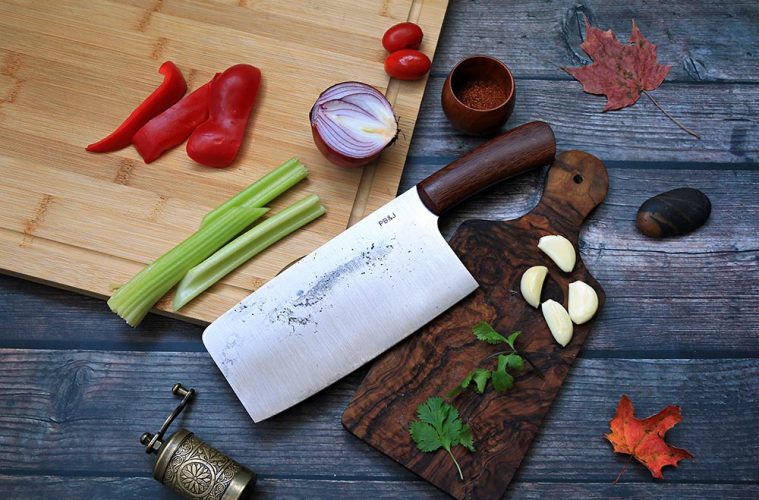A GREAT FOOD PREP BLADE FROM GUYS WHO LOVE TO COOK OUTDOORS
Several years ago at a knife trade show, I saw a table full of rustic knives and one very large Parang. A sign there read PB&J Handmade Knives, which were made in the USA. I thought it was an interesting name; I always liked peanut butter and jelly as a kid. PB&J comprises three guys: brothers Phillip and Barry Jones, and Jake Kirks. The P stands for Phillip, the B stands for Barry, and the J stands for Jake—all coming together to make up PB&J Handmade Knives.
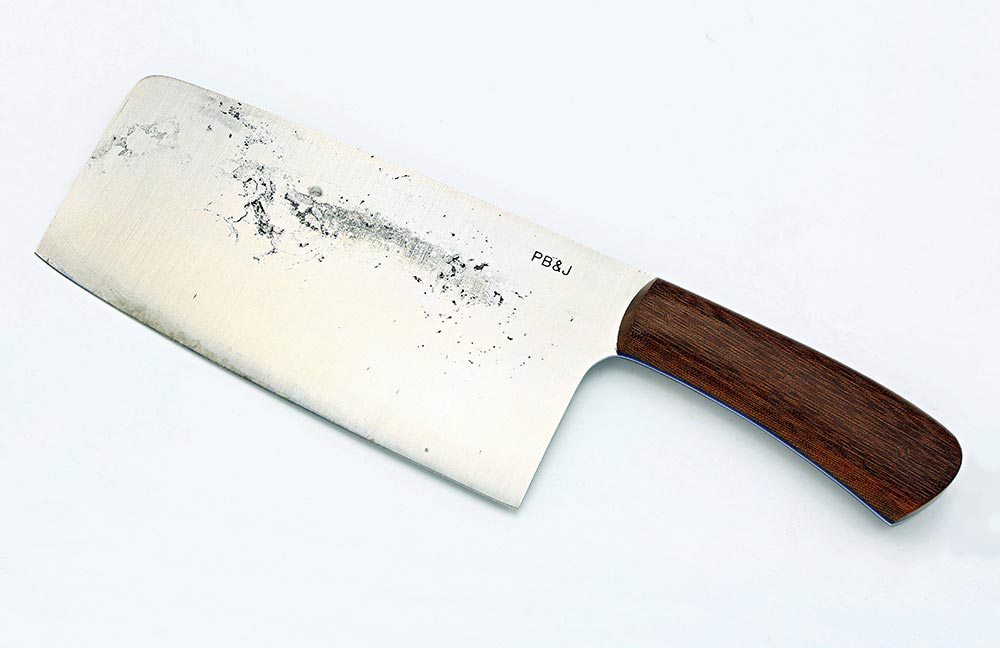
The Veggie Cleaver from PB&J Handmade Knives features a 15N20 blade, Micarta scales and convex edge. The overall length is 11 ½ inches, with a 7-inch blade.
THE PB&J WAY
These guys like cooking just about as much as I do. Be it indoors or outdoors, PB&J love to cook! I’ve had conversations and emails about this with them—it’s true. Catching up with Barry Jones on the telephone and by email gave me a chance to peek behind the PB&J curtain.
KI: What made PB&J start making kitchen cutlery?
BJ: We started making kitchen cutlery because all three of us love to eat good food. We really enjoy cooking outdoors on open fires and do so as often as possible. Our social media postings of our cooking endeavors pushed us into making our own food prep cutlery so we could have not only a decent knife to use to prep our food but one to show off on the internet. If you aren’t using your own knives, how can you expect your clients to?
KI: Do you all enjoy cooking inside and outdoors?
BJ: Phillip and I cook all the time, indoors and outdoors. Our parents and grandparents rarely went out to restaurants to eat, and that was instilled into us. Preparing our own food just makes sense, too. We can control every aspect of what we eat.
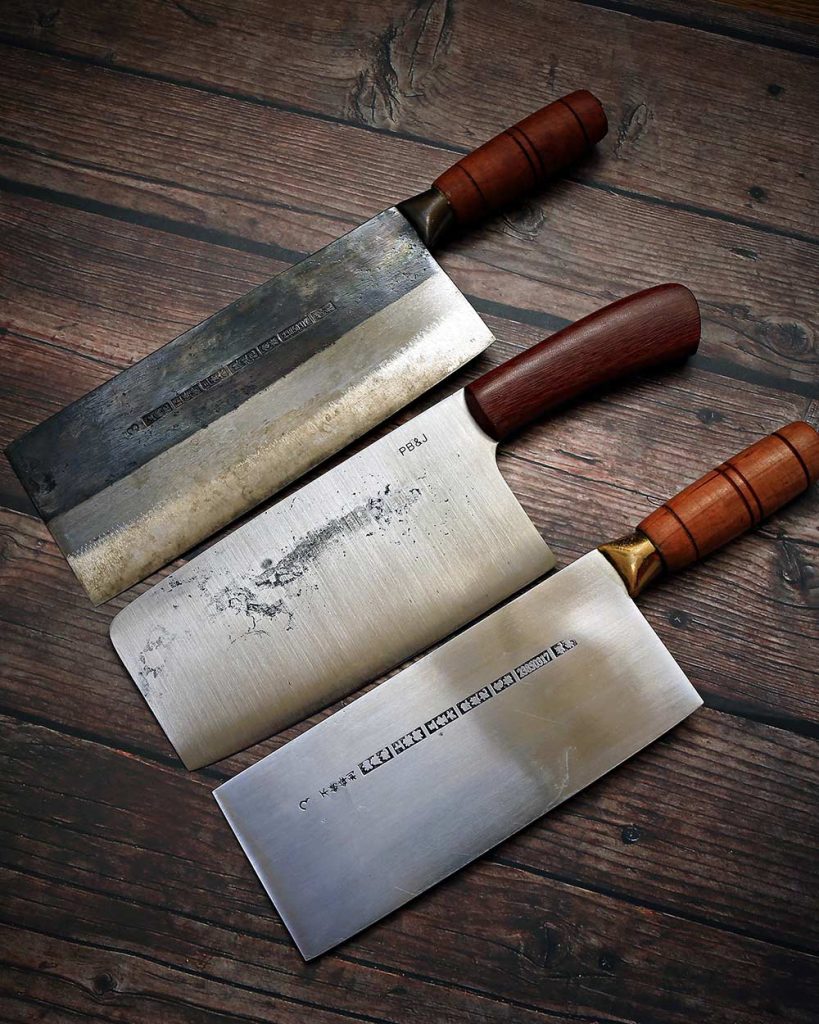
Two Chinese vegetable cleavers surrounding the PB&J Handmade Knives Veggie Cleaver (middle). All have similar thinness and performance.
KI: What type of materials do you favor for outdoor knives and kitchen knives?
BJ: I can’t really say that we prefer one material over any others for any of our knives. We value performance and quality. Both can be obtained with a wide variety of materials. It boils down to how the steel is heat-treated and how the knife blade is shaped.
KI: Why 15N20 steel for the cleaver?
BJ: I’ve got to be blunt and honest here. The 15N20 steel we use for our kitchen cutlery comes from recycling old lumber mill bandsaw blades. The saw blades we get are thin and wide. It just made sense to make a thin, wide cleaver out of it. The steel makes an excellent kitchen knife. It’s easy for us to work and it performs extremely well.
KI: What is your favorite dish to make outdoors?
BJ: This is a difficult question to answer. We cook a variety of different foods outdoors and really enjoy them all. I’d have to choose a venison stew.
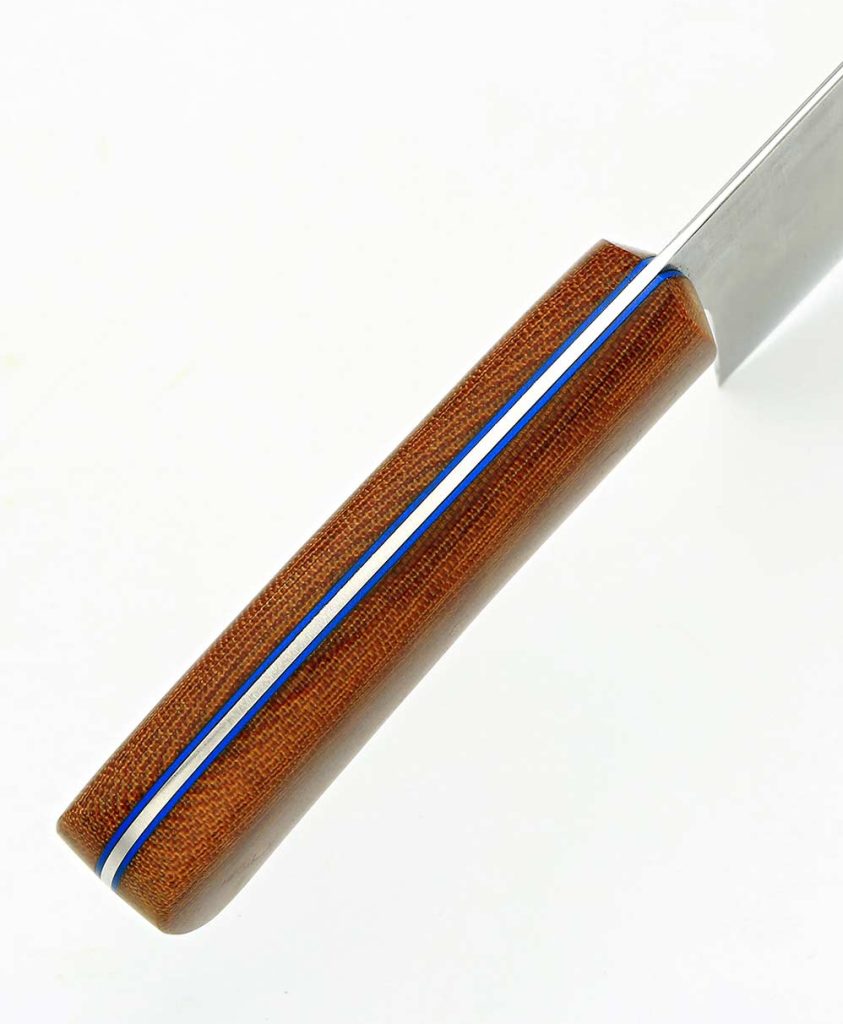
The handle features brown, crosscut canvas Micarta scales with blue G10 liners. Three brass pins hold the scales in place.
VEGGIE CLEAVER
The PB&J Veggie Cleaver keeps with the more traditional chef’s knife and cleaver size with a blade that’s 7 inches long. Overall length rests at 11 ½ inches, with a 3/32-inch-thick spine that is great for slicing.
The steel is 15N20, better known as bandsaw steel. This steel is used for kitchen knives, filleting knives, woodworking tools and even swords. It is also common to see 15N20 used with 1095 or 1084 steel to create pattern-welded Damascus steel. A full convex-ground blade is used on the PB&J Veggie Cleaver.
“Phillip hand-sharpens every kitchen knife we make,” said Barry. “He sharpens on oil stones using no jigs or tools to set the edge angle other than his eyes and hands.”
The attractive handle features brown, crosscut canvas Micarta scales with blue G10 liners that really pop and add another degree of excellence to the handle. Brass pins hold the scales in place and give it some class on top of all that. The cleaver has no sheath, as it is a kitchen knife. I made a cardboard and Gorilla Tape DIY sheath to transport mine to the woods.
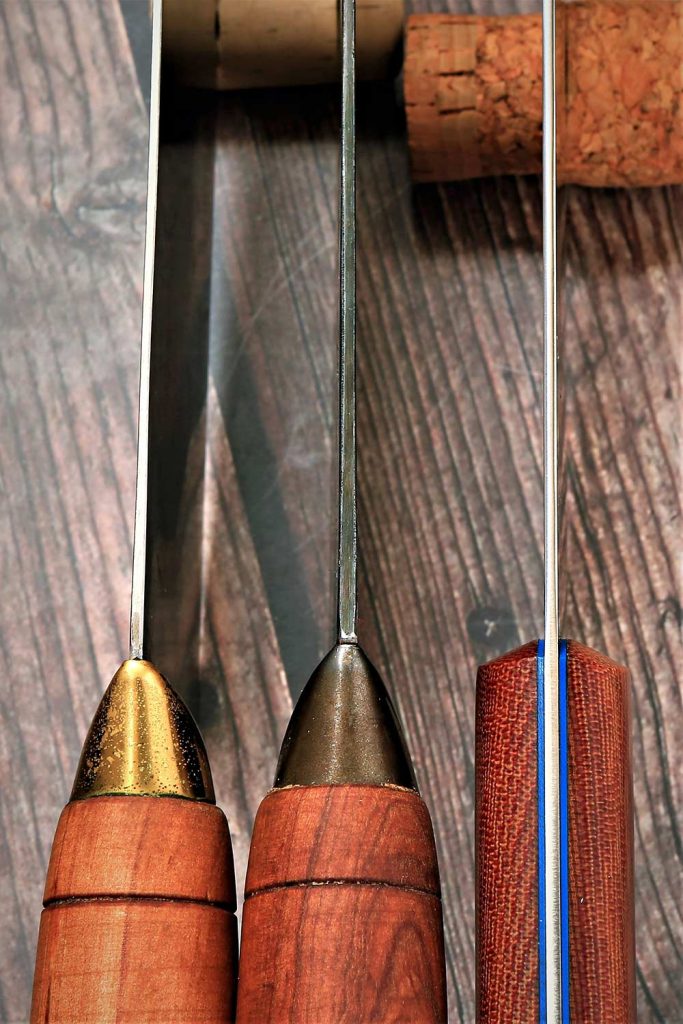
Here, two Chinese vegetable cleavers can be seen with the PB&J Handmade Knives Veggie Cleaver, full tang (right). The spines are thin, with the two Chinese cleavers featuring rattail tangs.
KITCHEN KNIFE BASICS
Regarding proper kitchen knife techniques, three stand out as basic rules no matter what type of knife you are wielding. Tap chopping, cross chopping and rock chopping will meet about 90% of your cooking needs. It’s worth a few hours to look into these techniques and practice as much as possible.
However, we can’t get into these without first addressing the claw grip. Not the Jim Carrey claw from the movie “Liar Liar,” but the grip you need to use to avoid a knife mishap.
In the world of culinary cooking, the claw grip is a safe way to hold food items with the support hand while the knife hand performs its duties. This keeps a sure grip on food while the knife hand slices, cuts and chops whatever is needed.
The best position for the support hand (non-knife hand) is making the claw, with the fingertips curled under and knuckles pressing down on the ingredient to keep it from rolling or sliding. At first, it may feel odd, but it’s the safest place for your fingertips in relation to the cutting blade.
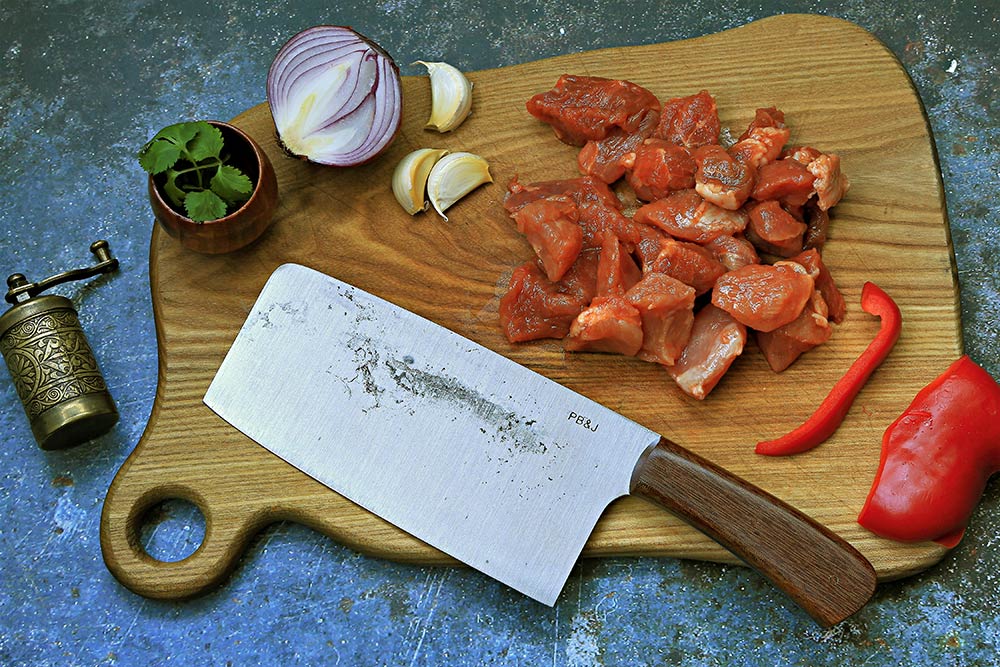
The PB&J Handmade Knives Veggie Cleaver was used to prep pork for kabobs. The thin slicer is right at home working with meat and vegetables.
LET’S GET COOKIN’!
The PB&J Veggie Cleaver arrived right in time. Once the weather cools down, and the color of the forest looks like someone has had a heavy hand on the saturation level of a photo, it’s time for chili. That’s right: Cold weather, comfort food in the woods and the home kitchen are the highlights of my days.
A few dishes I had in mind to prepare with the PB&J Veggie Cleaver were chicken soup, chili and hobo foil packets. I chose to do all the food preparation indoors that I would need for the duration of the test period.
CHILI CON CARNE
Perhaps the best dish I’ve prepared with the help of the PB&J Veggie Cleaver as of yet was chili con carne. This is prep-heavy, as veggies need to be chopped and diced. I used all the techniques like cross chopping, tap chopping and rock chopping to get the correct sizes.
I like a lot of vegetables in my chili. I know people from different places pride themselves on their chili and stick to strict rules. Some states don’t use beans, some areas don’t use meat and others don’t use tomatoes. This is my version of chili con carne (with meat), and I like it just fine.
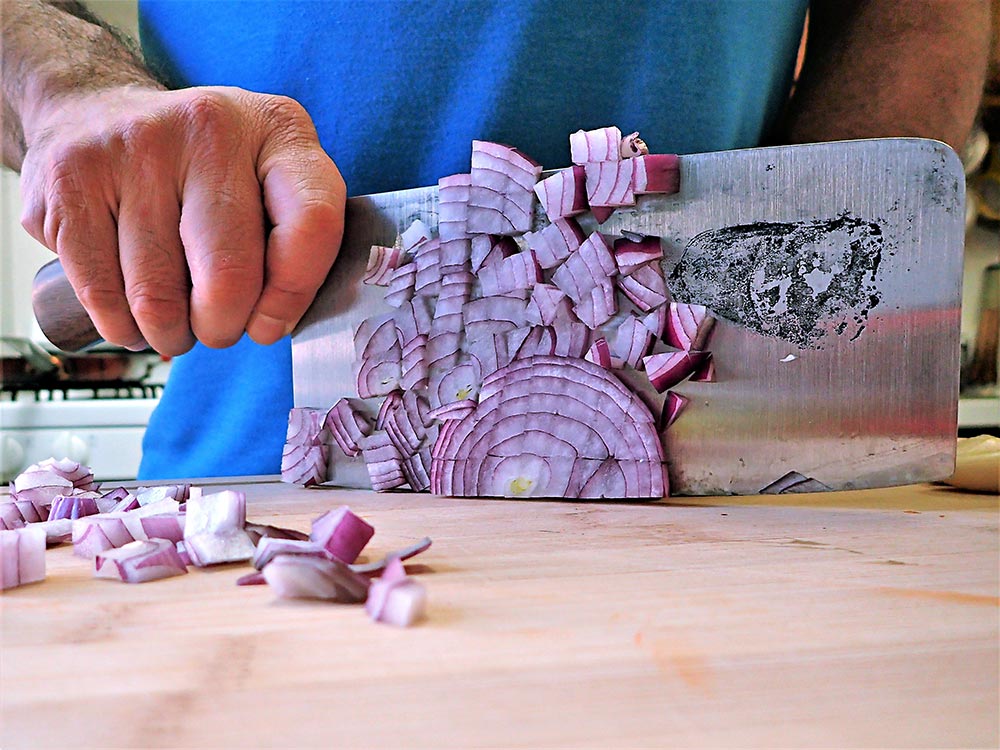
The author displays cleaver techniques for dicing an onion for making chili. He uses the pinch grip about 90% of the time in the kitchen.
Most of the work is in the preparation of the vegetables. I use onions, garlic, celery and bell peppers, as well as ground beef, crushed tomatoes, kidney beans and black beans.
Prepping the veggies was fun and effortless. I first noticed the weight difference between my regularly used Chinese cleavers and the PB&J Veggie Cleaver. The lightest cleaver I got from Hong Kong weighs 8 ounces, and the largest is over 9 ounces. The PB&J Veggie Cleaver weighs 11 ounces and is full tang compared to the rattail tangs on my Chinese cleavers.
“If you aren’t using your own knives, how can you expect your clients to?” —Barry Jones
The handle was comfortable, and the blade was beyond sharp. Most Chinese cleavers have a straight, flat edge, as do mine. The PB&J Veggie Cleaver hints at a curve up towards the front of the edge.
It can easily be seen in the photos that the blade distance from the spine to the cutting edge is less than near the handle. This gives the knife some belly, makes rock chopping smoother and allows it to roll more than a flat, Chinese-style cleaver.
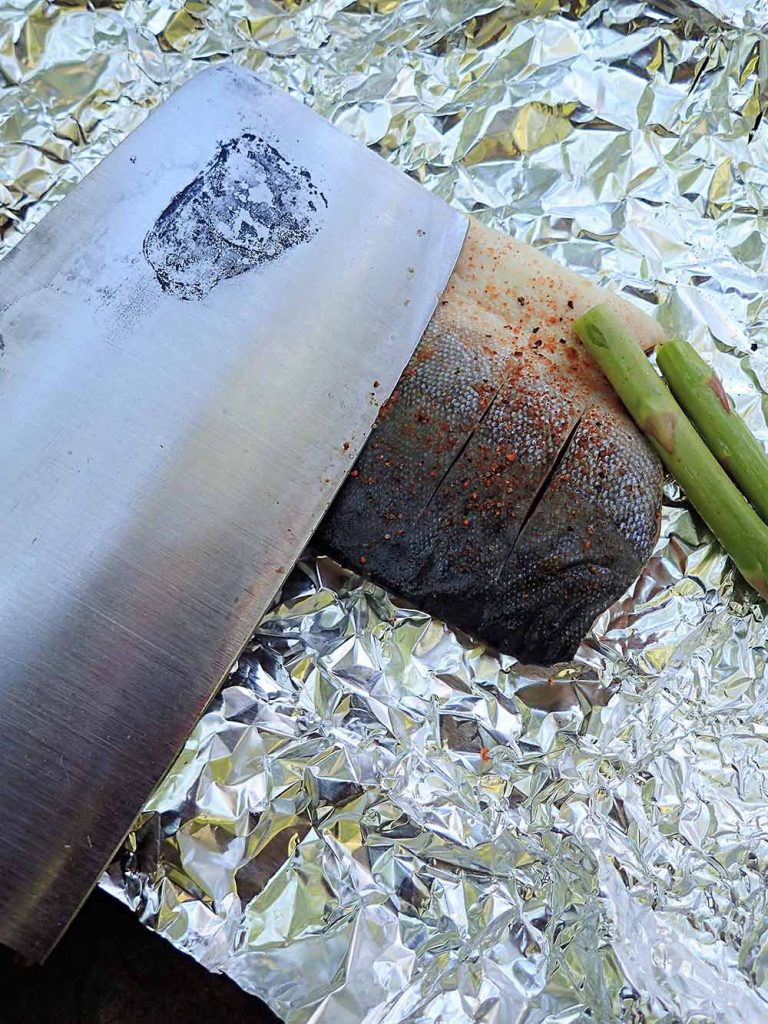
The author scored salmon for a foil-pack meal cooked in coals. It takes a sharp blade to easily cut through salmon skin without ruining it.
SALMON HOBO PACK
For my foil-pack dish, I needed to score the salmon skin to ensure thorough cooking. I would consider this a delicate task, as a sharp knife is required to cleanly slice the skin.
Carrots take a while to cook, so cutting them small was essential to match the cook times between salmon, asparagus and hard carrots. I had a simple, disc-shaped cutting board in the woods, just enough for this simple preparation. The PB&J Veggie Cleaver was an essential ingredient and key to success for this and many other dishes.
“The handle was comfortable, and the blade was beyond sharp.”
CHICKEN SOUP
A classic with a twist. Years ago, I had the best chicken soup in Alaska with corn and lots of black pepper. This changed my chicken soup recipe for good. I set out into the woods to make this northern chicken soup. I started out with a chicken leg. I separated the thigh from the drumstick with an easy cut just beside the fat line, through the joint where it cuts easiest. I removed the backbone attached to the thigh, as cheaper chicken legs often have this attached. The front portion of the cleaver sliced easily.
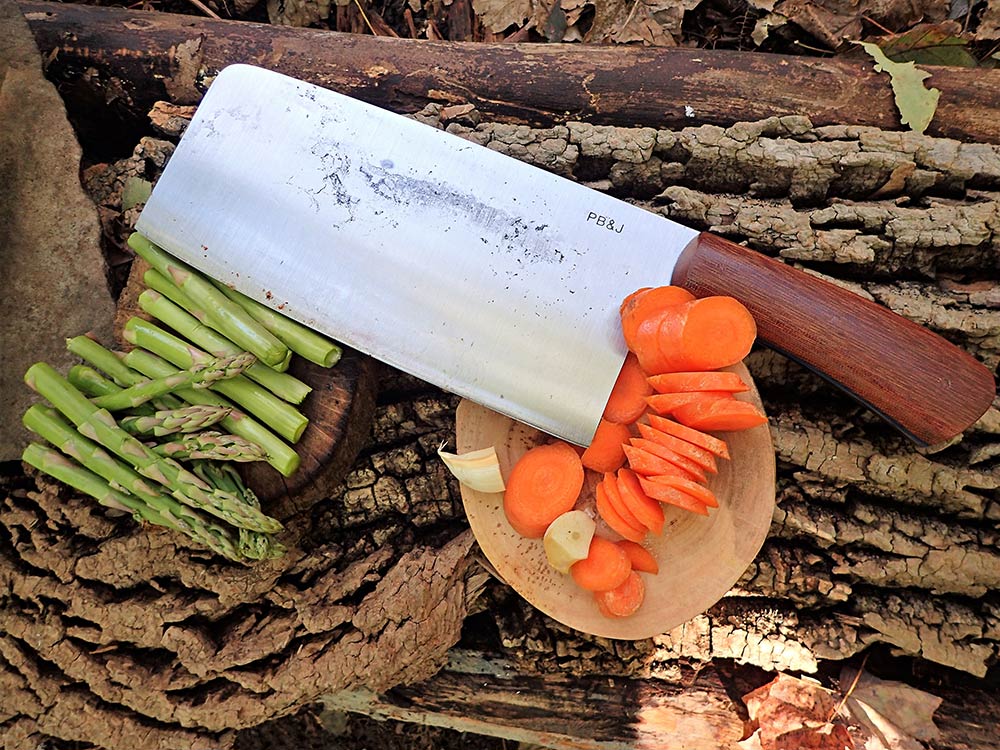
Slicing hard veggies like carrots and softer veggies like garlic and asparagus was no issue for the PB&J Handmade Knives Veggie Cleaver.
Deboning with a cleaver is an art form beyond the scope of this article. It involves breaking back the joint between the thigh and hip, then cutting through it while preserving as much thigh meat as possible. The bone can go in the pot, and the small amount of meat on it can be shredded into the soup.
“The PB&J Veggie Cleaver was an essential ingredient and key to success for this and many other dishes.”
Best of all, deboning adds flavor by allowing the other parts to cook easier, having been reduced in size. Soups and stews have always been about capturing and preserving as much flavor as humanly possible.
A sharp knife makes this possible and skates along bones without their needing much touching up. As with the other ingredients, I sliced celery, onions and carrots with zero issues—just as easily as with thinner veggie cleavers. Success!
FINAL CUT
These boys from Virginia know how to work 15N20 steel and how to put an edge on a tool. The PB&J Veggie Cleaver ticks all the boxes on what a thin cleaver is meant to do. It performed flawlessly, and I look forward to whatever the PB&J crew comes up with next.
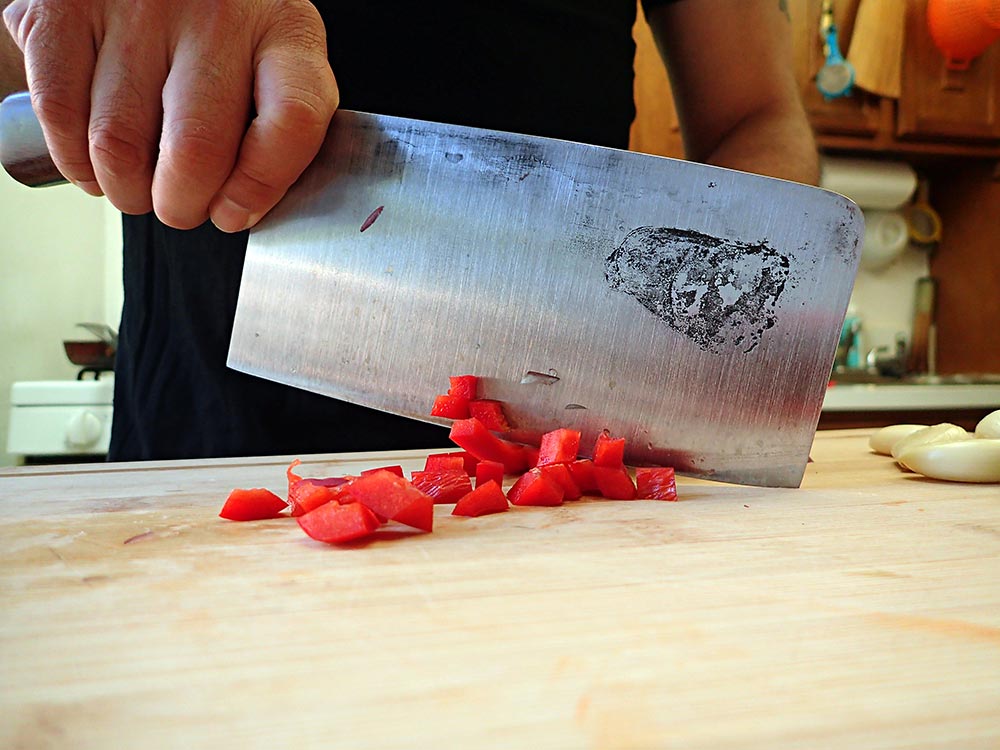
See how the repetitive motion of rock chopping utilizes the tip of the cleaver downward towards the hilt. The opposite hand pushes the material forward.
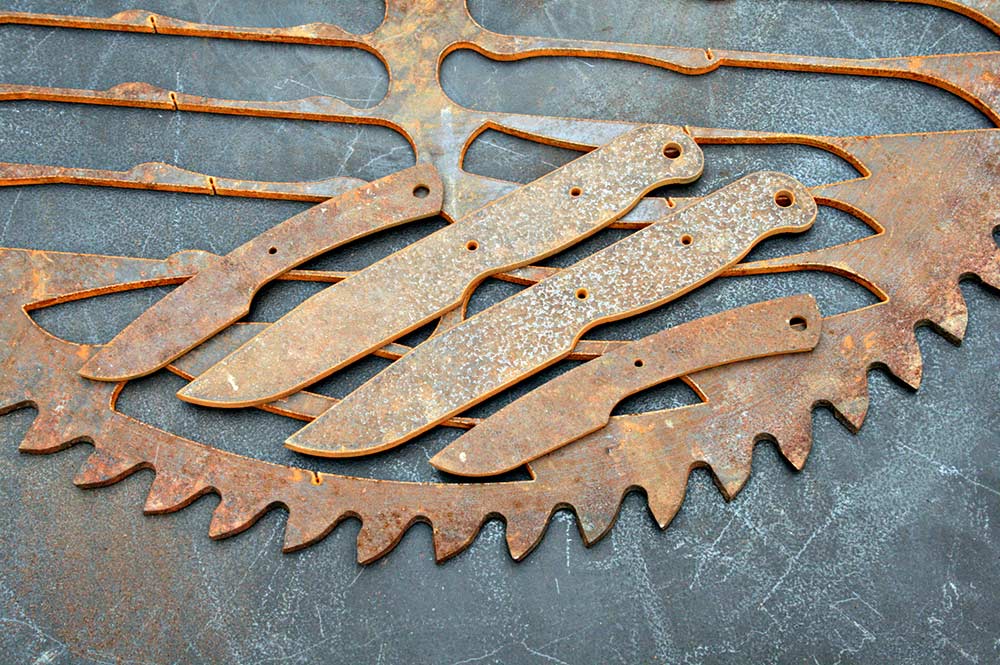
This is what PB&J Handmade Knives uses for its cutlery: the same type of bandsaws that helped build this country.
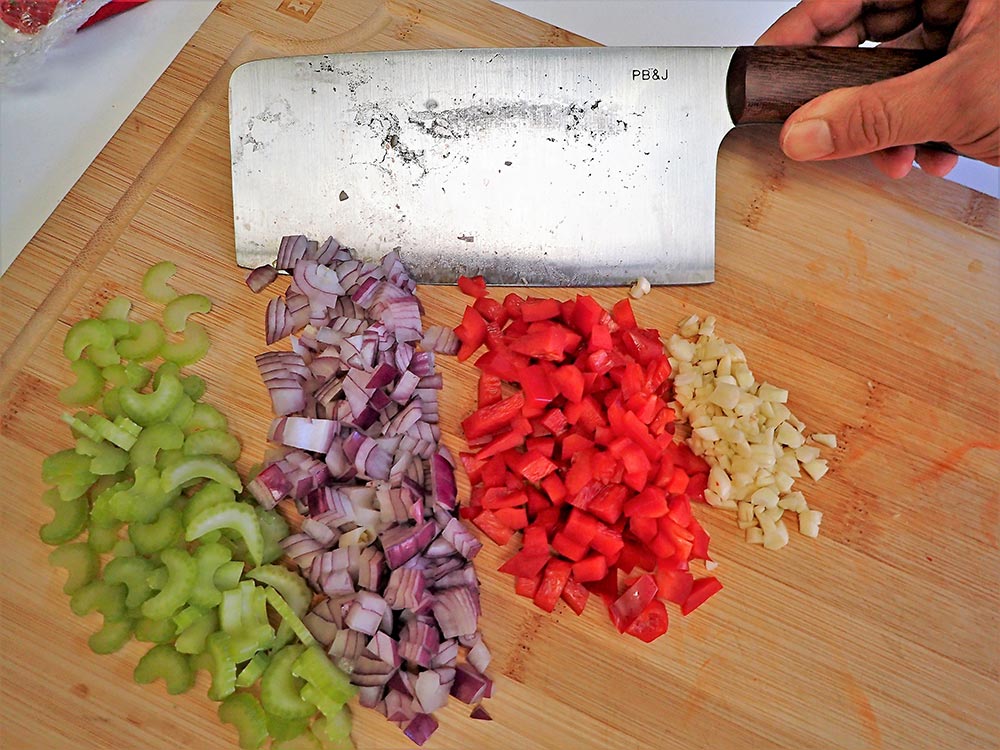
Preparation for chili con carne was a breeze for the PB&J Handmade Knives Veggie Cleaver. The author used only three techniques, all with great success: rock chopping, cross chopping and tap chopping
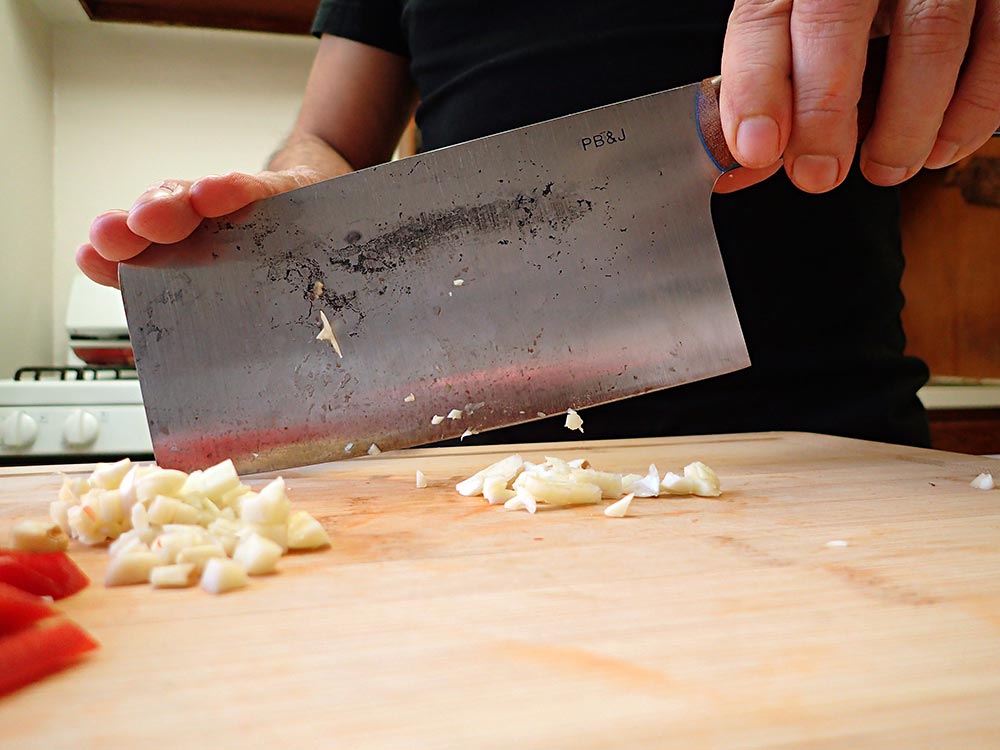
The author is cross-chopping garlic for a fine dice. This is the safest and easiest way to chop herbs and dice meat or vegetables.

The driving force behind PB&J Handmade Knives is (left to right) Phillip Jones, Barry Jones and Jake Kirks.
BASIC KITCHEN KNIFE SKILLS
Tap Chopping. Holding your forearm roughly perpendicular to the cutting board, use your wrist to bring the tip of the knife up and down. Cut the vegetables with the back 1/3 of the blade, letting the weight of the knife do the work. This action will make a tapping sound.
Cross Chopping. Regularly used if you need to quickly chop small vegetables or herbs. Holding the knife’s handle with one hand, put the palm of your other hand on top of the blade (this helps you guide and control the chopping pace). Keep the blade tip down while you lift the knife’s handle to chop. Your hands are safe because they’re out of the way.
Rock Chopping. Similar to performing the cross chop, hold the blade’s handle and keep the tip of the knife down on the board, but with the rock chop, you use your other hand to move the ingredient. As you chop, you will keep the blade still while pushing the vegetable forward.
Reminder: Curl your fingers to keep them safe from the blade.
WHAT IS 15N20 STEEL?
15N20 is high-carbon, high-nickel steel popular for its outstanding toughness and versatility. This steel is sometimes used with 1075, 1095 and 01 steels from Damascus steel manufacturers. Don’t be surprised if you come across a 1080/15N20 or 1095 and 15N20 steel alloy knife.
Since it has a relatively low degree of difficulty to work with, 15N20 is an excellent steel for beginners and professionals who want to use it for knifemaking.
So, what is 15N20 steel used for? This steel is mainly used for making knives of all sizes. You’ll find it in kitchen knives, filleting knives, swords and woodworking tools. 15N20 is also commonly used with 1095 or 1084 steel to create pattern-welded Damascus steel.
SOURCE
PB&J Handmade Knives
Phone: 434-857-6358
Email: jonesbros@comcast.net
Facebook Group: PB&J Handmade Knives
Instagram: pbj_handmade_knives
A version of this article first appeared in the Jan/Feb 2023 print issue of Knives Illustrated Buyer’s Guide.

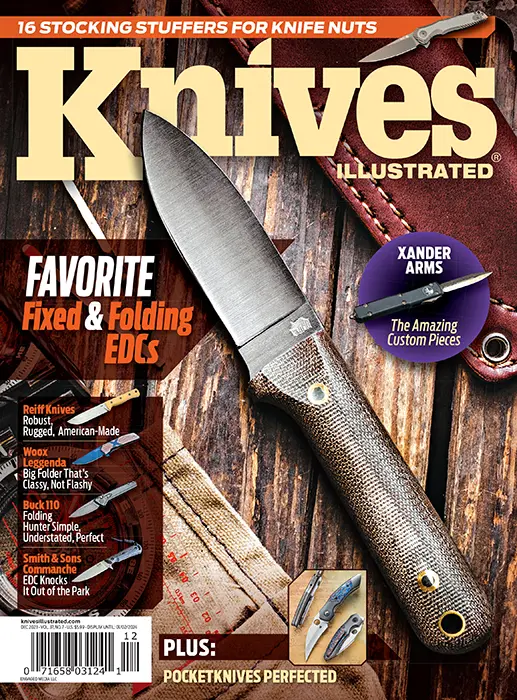 Subscribe / Back Issues
Subscribe / Back Issues